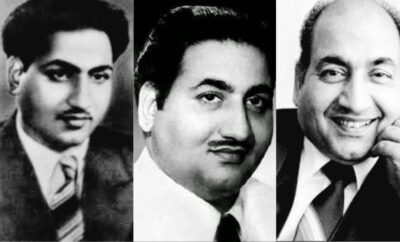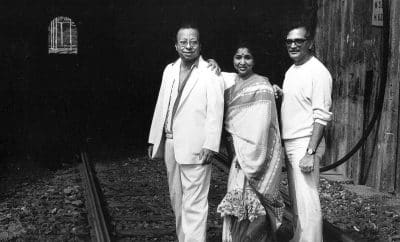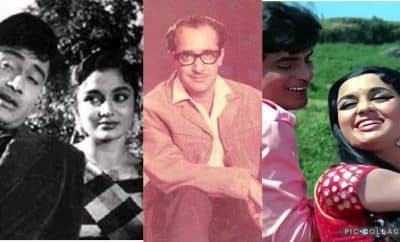Collections
Pancham And His Jalpari – Tale Of Choral Tail
Last year, Pancham, exactly on this date I embarked on the journey of your songs with the influence of ‘Kahaa tha tone sanam/ Kotha je hariye gele’ more known as the Jalpari theme from Saagar. The trend in the film industry nowadays, be it Hollywood or Bollywood , is of the sequels of the hit movies. That’s why I am treading on this trend to present the sequel (the remaining half) of the Jalpari article to commemorate the twenty fifth anniversary of your departure to the heavenly abode.
Like a mermaid, your jalpari music can be identified by two distinctive parts, first , the lovely buildup of the emotion / yearn of the beloved , as lovingly detailed as a mermaid’s cute face/ mukhada that was discussed extensively in the first article. With this sequel article let me tell the readers the tale of the choral tail, the tail that follows as smoothly after the mukhada as aerodynamic or the aqua-dynamic as the shape of the tail of the mermaid. Agreed that compared to quite a few instances of jalpari mukhada the instances of choral tail are lesser just like the narrowing shape but no less interesting with the cute little twists in its end.
(Note- I have consciously avoided the early entries even if they carry this choral essence)
So, here we go.
Saagar (1985):
The biggest tributary to this write up thread is this film, ‘Sagar’, a 1985 release. Like you and your mermaid, Sagar and Jalpari are made for each other. In fact she derives her name just because of Sagar. Both derive their recognition from each other. With Ramesh Sippy uniting again with you, it was like perfection uniting with another perfection. He identified the west coast of India and settled into a Konkan village to tell the story of a love triangle on the backdrop of the vast Arabian Saagar. There was this backdrop of the ocean for every emotion of the characters be it the friendship, rejoice, love, betrayal, separation or reunite. And so was the Jalpari music and moreover the Choral tail that wiggled majestically in many instances. I am enlisting some of those instances while not repeating the jalpari scene which was dealt in the earlier half.
Title Music : Like the western theme title for the western influenced Sholay , the title you composed for this em-Ocean-al film was aptly sentimental. Just like the ‘bheeni bheeni bhor’ the title wakes up on the natural sounds of the coastal village and rides on the overwhelming tides of synths to the cutely strummed title love song ‘sag ar kinare’ and then to the celebrity choral phrase to follow. What a lovely framework to the whole scenario! You just didn’t stop there but continued it more with a mind-blowing whistle to cruise on the pleasure graph upwardly.
https://www.youtube.com/watch?v=BMpsYe0p9jQ
Chehra hai ya chaand khila hai – Saagar :
One of those countless superhit Kishore solos that beautifies the second meet of Rishi and Dimple and who else but the choral jalpari to celebrate that moment of falling in love at the first site?
The Youtube link given below also includes the precluding scene in the fare. The way the phrase rides upwards while the couple in the wheel, the way the music clings to the wheel, the way the camera rises to the occasion is simply goose bumps.
Sippy then shows his prowess of shooting the songs. A lovely dream run amidst each antara is simply to wait and die for. And so is Pancham’s compositional and Javed saab’s lyrical complement. That dream run, however, has pleasant improvisations instead of just repeat sequences.
First antara launches on the build-up of guitar and violins and the couple dreams along ‘kaise kaise khwab yeh dil’. The violin run punctuates the progression beautifully while freezing the buzzing action in the fare. Kishore’s softly whispering rendition underlines the urge of Rishi Kapoor before returning to the noisy reality.
Second antara tops the expectation built up by the first. The dream run is now initiated by the staccato strums that are followed by the fluently dynamic violins like the storm of the dust. The crowded place becomes pleasantly deserted to welcome the choral Jalpari that accompanies the running couple. The camera rides the vertical wheel to capture the scenic overview of the couple, the fare and the other wheel merrily going round along the vertical axis. The soft whispering portion like the first antara becomes aptly non-synched as Rishi is still gathering breath after that dream run.
EVERYTHING IS FARELY FAIR IN THIS LOVE SONG.
https://www.youtube.com/watch?v=Ai9ASF9C6WM
Saagar Kinare : Sad version – Lata :
It’s not only the joyous moment that is accompanied by the Saagar and the jalpari but here, in the sad version, too, the Saagar with the dark red skies and the jalpari tail accompany the distressed couple, the sequence which finally ends on the surging note of reunion.
This is not just the sad version. Sippy and you, Pancham, were never that lazy. You really came up with superb and apt improvisations. The foremost being the first passage of Lata (‘saagar kinare saanj savere’) that treads on that poignant antara ‘ biraha ki maari prem diwani’ of the nostalgic and iconic ‘raina beeti jaaye’ and why not? Both of them are in the same emotional state of the separation. Not only this but the poignant descent along ‘kyun hai yeh dooriyaan’ and the emotionally twisting rise ‘ek too paas hai ..ek hi aas hai’ are equally consuming which finally bring to the shore of the main antara of ‘saagar kinare’ although in slightly higher pitch.
Simply hats-off to these magic-makers!!
Tomari cholar pothe – (Ekanto Apon- Bangla)
It was not only the Arabian Sea on the western coast of India where the jalpari thrived. The Bay of Bengal, too, was her thriving place. And why not when You, its creator, belonged to the place on its bank .
‘Tumi koto je dure’ that has full jalpari was released nearly simultaneously with Sagar. Not only that this Victor Banerjee- Deboshree Roy starrer bangle movie also had an Asha solo that had the glimpse of the choral jalpari . The album was stunningly replete with the bangla versions of ‘tere liye jeena’ , ‘maazi re maazi’ and more. This solo was pleasantly odd for its shyly romantic expressions of Deboshree and your and our Bhalob-Asha.
It is always a pleasant feeling of having a long ride with your songs owing to your amazing sense of dynamics, be it the flamboyant ‘keh doon tumhein’ or the monsoon ride along ‘kaho kahaan chale’ or the youthful ‘tumhein chhod ke’ . This song is a soothing cruise along ‘tomari cholar pothe’ flanked by the lush and lovely landscapes and that too driven by our Bhalobasha Asha.
It won’t take one a minute after he board the song to exclaim “Oh wow ..yeh , yeh hai wahee (tune) dil ne jise apna kahaa”. When he treads further to the antara he wonders “saagar jaise antare-wali yeh to bataa tera naam hai kya?” The build-up is so much reminiscent of the softer part of saagar antara (“dil kehta hai too hai yahaan to”) and while he is consumed in these thoughts , the choral jalpari shows its presence riding on the poignant flutes in the second interlude. The presence is so slight that one might miss it on the first ride. But when it is identified the thought comes to mind that “Oh, it’s Sagar so jalpari presence is logical” but how you did it is simply awesome.
Pancham : Ek tu amar bhalobasha
https://www.youtube.com/watch?v=rfGFIr6DdiI
Nee Azhutha Kanneer – Ulagam Piranthathu Enakaga
It was the same ‘bloody fellow’ of yours, S.P.Balasubramanyam whom you gave responsibility of rendering the hindi version of ‘tumi kato je doore’, brought you to the south east coast of India to compose some Tamil and telugu films. They presented some stunning regional remakes of your blockbuster hindi compositions. Arrival of jalpari was always on the cards.
This is quite an emotional rendion by SPB which was the remake of bangla song discussed just before. The vinyl also packs its solo violin instrumental.
Meri dua hai – Raahi badal gaye :
A beautiful tandem song for well wishing of Padmini Kolhapure on her birthday, one Kishore solo and the other a duet between Shailendra Singh and Kavita Krishnamoorthy. You composed another ear-catching tune, as usual with the antara built on the choral jalpari progression.
Simple yet Lovely words by Gulshan Bawra decorate the birthday occasion while the choral Jalpari makes the already great celebration a grand one by appearing in the antara progression but ever so subtly. This composition, again, has a cruising pace with a soothing progression with assuring vocals of Kisjhore. What else would one wish for?
The tandem serves as the icing on that birthday cake with lovely vocal varieties. Although after listening Kishore you would crave to listen to no one, Shailendra Singh has always been lucky mascot for Rishi right from his first film. So, it’s no harm in giving it a try.
Kishore solo
https://www.youtube.com/watch?v=imbEjPcR6dI
Shailendra-Kavita duet
The last song in this brief compilation now coming up, but certainly not the least.
Toone kiya kya jaadoo : (Apne Apne-1987)
‘Tumi kaato je doore’ revisited in new grand form and how!! After going with youthful Amit kumar for the young Karan Shah in Jawani and even in the other song of the album (‘teri yaad mein neend na aayi’) , Pancham, you decided to exercise your limitless vocal chords for a provocative situation that needed the emotional Punch and craziness which only you could provide. Karan Shah must have made quite an effort to lip-synch..errr.. throat-synch to be more precise.
The song is lavishly landscaped replete with your trademark instruments, their tone and the pace, the genres to complement the provocation appeal of Mandakini. The choral Jalpari progression once descended gracefully now is in its amazingly colossal pace and fall like a roaring waterfall which is to be only heard to believe.
https://www.youtube.com/watch?v=trxNQUam8GI
Pancham, indeed , tune kiya kya yeh jaadoo that even after twenty five years of your demise one still yearns for your reappearance. If it was not for the legacy of seemingly countless melodic and experimental songs, it would have been like “tere bina dil kahe bas jeena hi naheen”.




Pingback: Carnival of Blogs on Golden Era of Hindi Film Music – January, 2019 – The world is too small? or Is it?